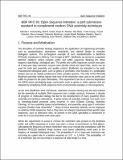| dc.description.abstract | The discipline of synthetic biology emphasizes the application of engineering principles such as standardization, abstraction, modularity, and rational design to complex biological systems. The archetypical example of such standardization is BioBrick RFC[10], introduced in 2003 by Tom Knight at MIT. BioBricks are stored on a standard plasmid, pSB1C3, which contains prefix and suffix sequences flanking the DNA sequence specifying a biological part. The prefix and suffix sequences contain two pairs of 6 base-pair (bp) restriction enzyme sites (EcoRI+XbaI and SpeI+PstI), which can be used for both part assembly and quality control. BioBricks are intended to be well- characterized biological parts, such as genes or promoters, that function in a predictable fashion and can be readily combined to make complex systems. The rules of the RFC[10] BioBrick assembly method require that none of the restriction sites used in the prefix and suffix be present in the parts themselves. This requirement can be an onerous imposition for iGEM teams developing large, novel parts, such as genes or entire operons that are obtained by amplifying DNA sequences from environmental samples or microorganisms.
While iGEM teams may use methods such as site-directed mutagenesis to remove illegal restriction sites from a part's sequence, it is certainly possible that this mutation will alter the functionality of the part – a very undesirable outcome. In addition, the mutagenesis of illegal restriction sites is an unnecessary burden on teams, given the limited time and resources available to teams during each year’s iGEM competition. Efforts spent mutagenizing sites would be better spent characterizing and improving parts. This RFC proposes an alternative submission standard to eliminate these problems. | en_US |
